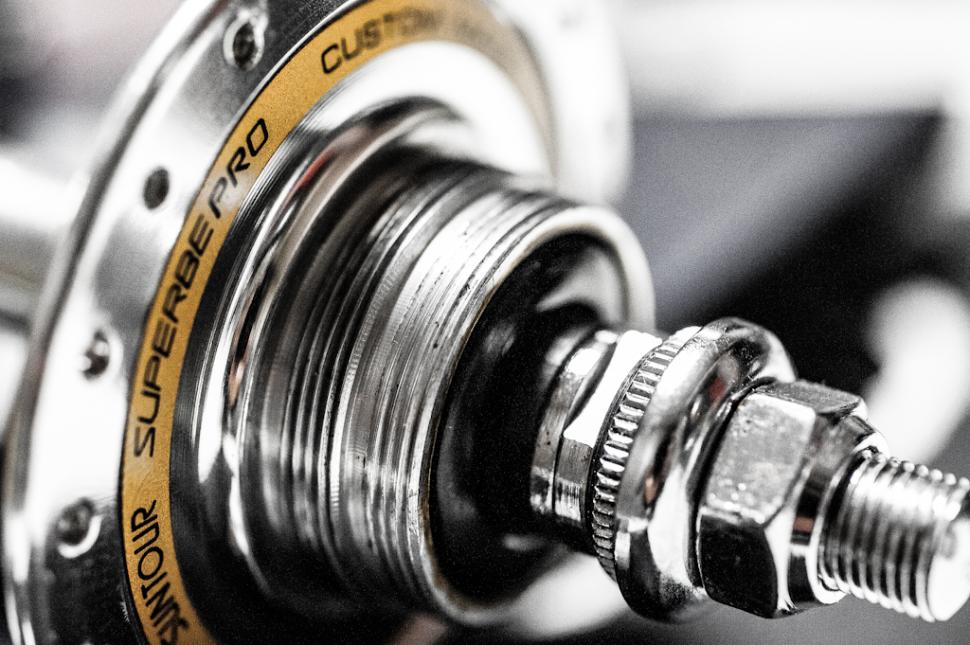SunTour got its start making freewheels in 1912, as Maeda Iron Works Company, owned by the Maeda and Kawai families and headquartered near Tokyo, Japan.

For 20-odd years from 1964 SunTour made the best-shifting rear derailleurs. SunTour’s design, the slant-parallelogram, kept the top jockey wheel much closer to the sprockets than the derailleurs of Campagnolo, Shimano or the many other derailleur makers of the 60s and 70s. The smaller the jockey-sprocket gap, the shorter and less flexible the chain run between them and the better the shifting.
In 1968, Junzo Kawai, a member of one of the two families that owned Maeda, decided to start exporting derailleurs. It was a well-timed move. SunTour rode to success on the American 10-speed boom of the 1970s and the early years of the mountain bike boom, rolling out new variants on its derailleur design annually. In 1980 SunTour sold 3,800,000 rear derailleurs.
The weak Yen of the era made Japanese bikes, equipped with Japanese components, a bargain in the US compared to European bikes and components, and SunTour was quick to react to the emergence of the mountain bike, cementing its position.

However, SunTour’s derailleurs were all variants on a theme: a lighter mechanism for racing, a sturdier one for mountain biking and so on. As the clock ticked on the expiration of SunTour’s patent, Shimano was cooking up a refinement of the design that was even more precise. Shimano combined it with a gear lever that clicked between gear positions to yield ‘indexed’ gearing. In 1985, Shimano introduced indexing on its pro-quality Dura-Ace group.
SunTour was slow to respond, and tried to make its indexing system work with its existing, unevenly-spaced freewheels, where Shimano had started with a clean sheet and designed gear lever, derailleur, chain and sprockets to work together. It took several years for SunTour to catch up, by which time it was too late.

During its years of derailleur domination, SunTour also made what would turn out to be a disastrous business decision. While its rivals were charging what the market would bear, SunTour simply added a mark up to its manufacturing costs. Shimano used its profits to expand, making its own brakes and chainsets as well as gears and pumping resources into a 200-strong product development department. SunTour didn’t, and in order to offer groupsets to bike makers it had to partner with other manufacturers. It only had 20 people working on product development and, fatally, it didn’t have the resources to withstand an increase in the value of the Yen in 1985.
It took SunTour until 1990 to catch up with Shimano in functionality, by which time it was too late. Shimano dominated the market.
In the meantime, SunTour underwent a change of ownership, coming under the umbrella of Mori Industries, which had recently bought chainset maker Sakae Ringyo. Mori moved the production of most SR-SunTour components to Taiwan.
SunTour came up with some good ideas over the next few years, notably MicroDrive chainsets for mountain bikes that used smaller chainrings to provide lower gears and increased ground clearance, but it was a dead cat bounce.
In 1995 Mori sold SR-SunTour to the original owners of Sakae Ringyo in a management buyout. SunTour’s Japanese factories closed and company president Junzo Kawai, who had been instrumental in his family’s business since joining it as a 25-year-old in 1946, was out of a job.
The name survives in Taiwan-based SR-SunTour, which specialises in suspension forks, chainrings and e-bike motors.
